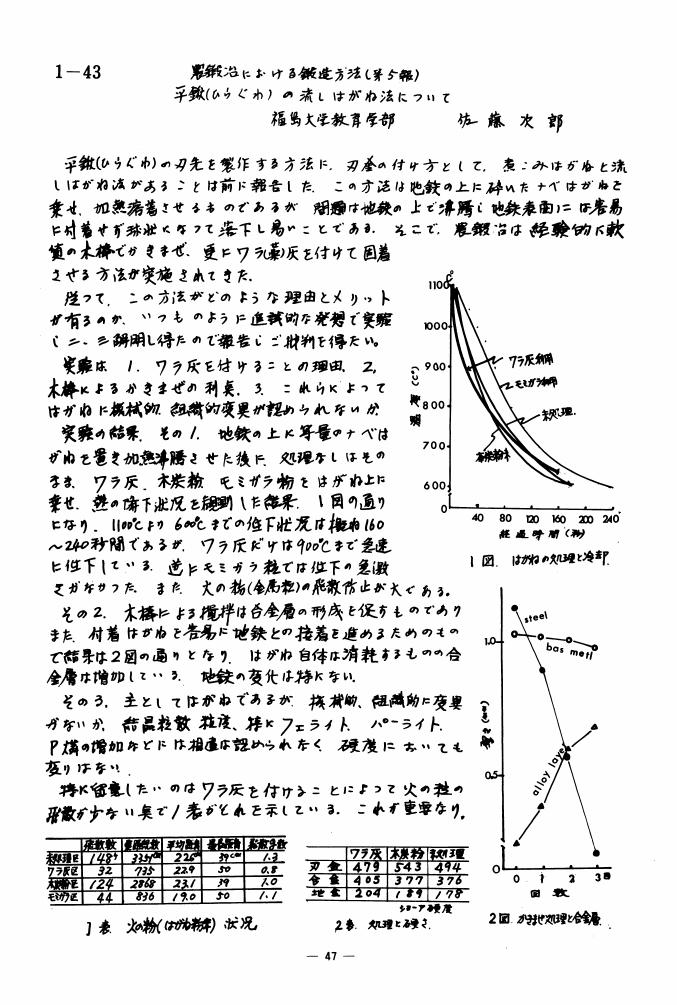1 0 0 0 農鍛冶における鍛造方法 (第2報):平鍬の製作工程と技術
- 著者
- 佐藤 次郎
- 出版者
- 農業食料工学会
- 雑誌
- 農業機械学会誌 (ISSN:02852543)
- 巻号頁・発行日
- vol.34, no.4, pp.385-391, 1973
With the progress of power farming, the number of farmer's blacksmithies has been decreased every year, as their main jobs ars to produce and repair Japanese-hoes. But I believe that their traditional technique is unique and excelent, and worth transmiting.<br>Following is the representative process and technique of producing Japanese-hoes by farmer's blacksmithies in Fukushima prefecture.<br>1) SS4IP, soft steel is used most often as the base steel of the hoes. Tamahagane (steel made from iron sand), Nabehagane (pan-bottom substitute for steel) and Zenihagane (coin substitute for steel) are used as the substitute for hard steel, and Nabehagane is used most often among them. Nabehagane and Zenihagane, so called by farmer's blacksmithies, are both old cast irons.<br>2) Pine-charcoal or Chestnut-charcoal are always used in forging, as the temperature of heating rises rapidly with them. Most tools for forging are self-makes by farmer's blacksmithies.<br>3) Ordinarily, Japanese-hoes are made through five steps, that is, preparing, cutting, forging, quenching, and finishing, and the process consists of eighteen unit operations. The main operations of them are marking-off, chiseling, drowing down, teyori (twisting), tewari (cutting), forge welding, and quenching. The operation of forge welding consists of crushing Zenihagane of Nabehagane into small pieces, placing them on the base steel, and melting them by heating over 1100°C. After then the welded steel is forged ten to twelve times. Quenching is the operation of heating the hoe up to 850°C and putting it into water of 30°C. Forge welding and heat treatment are the most delicate techniques in making hoes.
1 0 0 0 OA ドライフィルムフォトレジストの最近の動向
- 著者
- 佐藤 次郎
- 出版者
- 合成樹脂工業協会
- 雑誌
- 熱硬化性樹脂 (ISSN:03884384)
- 巻号頁・発行日
- vol.14, no.2, pp.92-103, 1993-06-10 (Released:2012-08-20)
- 参考文献数
- 12
ドライフィルムフォトレジスト (DFRと略す) はプリント配線板 (Printed Wiring Board. PWBと略す) の配線パターン形成用レジストとして広く用いられている。最近, PWBの高密度化 (ファインライン化, スルーホールの小径化, 多層化など) が急速に進んでおり, PWBメーカーの多様な要求に対応するために, 高密度PWBの製造に適したDFRの開発がレジストメーカーにより積極的に進められている。
1 0 0 0 OA 農鍛冶における鍛造方法 (第5報)
- 著者
- 佐藤 次郎
- 出版者
- 農業食料工学会
- 雑誌
- 農業機械学会誌 (ISSN:02852543)
- 巻号頁・発行日
- vol.38, no.Supplement, pp.47-47, 1976-04-01 (Released:2010-04-30)
1 0 0 0 OA 農鍛冶における鍛造方法 (第2報)
- 著者
- 佐藤 次郎
- 出版者
- 農業食料工学会
- 雑誌
- 農業機械学会誌 (ISSN:02852543)
- 巻号頁・発行日
- vol.34, no.4, pp.385-391, 1973-03-01 (Released:2010-04-30)
- 参考文献数
- 9
With the progress of power farming, the number of farmer's blacksmithies has been decreased every year, as their main jobs ars to produce and repair Japanese-hoes. But I believe that their traditional technique is unique and excelent, and worth transmiting.Following is the representative process and technique of producing Japanese-hoes by farmer's blacksmithies in Fukushima prefecture.1) SS4IP, soft steel is used most often as the base steel of the hoes. Tamahagane (steel made from iron sand), Nabehagane (pan-bottom substitute for steel) and Zenihagane (coin substitute for steel) are used as the substitute for hard steel, and Nabehagane is used most often among them. Nabehagane and Zenihagane, so called by farmer's blacksmithies, are both old cast irons.2) Pine-charcoal or Chestnut-charcoal are always used in forging, as the temperature of heating rises rapidly with them. Most tools for forging are self-makes by farmer's blacksmithies.3) Ordinarily, Japanese-hoes are made through five steps, that is, preparing, cutting, forging, quenching, and finishing, and the process consists of eighteen unit operations. The main operations of them are marking-off, chiseling, drowing down, teyori (twisting), tewari (cutting), forge welding, and quenching. The operation of forge welding consists of crushing Zenihagane of Nabehagane into small pieces, placing them on the base steel, and melting them by heating over 1100°C. After then the welded steel is forged ten to twelve times. Quenching is the operation of heating the hoe up to 850°C and putting it into water of 30°C. Forge welding and heat treatment are the most delicate techniques in making hoes.
1 0 0 0 IR ヤスキ鋼の熱処理における結晶粒と硬度について
- 著者
- 佐藤 次郎
- 出版者
- 福島大学教育学部
- 雑誌
- 福島大学教育学部理科報告 (ISSN:03870855)
- 巻号頁・発行日
- no.22, pp.51-63, 1972-11
